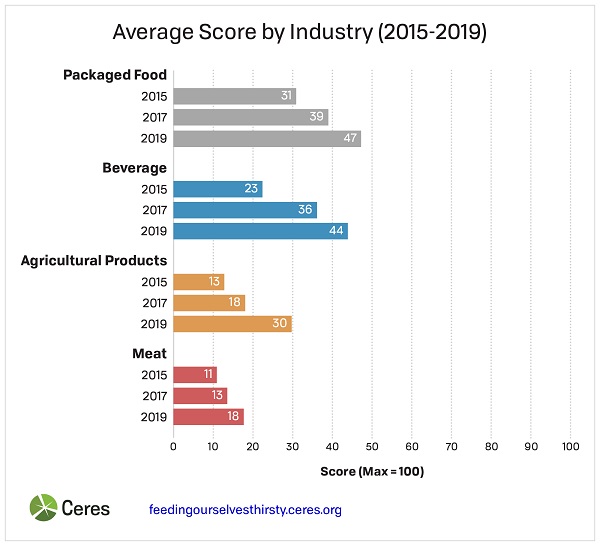
Food companies need to adopt far stronger practices to reduce their demands and impacts on limited water resources, according to a new report from Ceres, a sustainability non-profit organization.
Climate change is placing an unprecedented strain on water resources and agricultural productivity, hampering the growth prospects of the $5 trillion global food sector. And while some industry giants are rising to the challenge, finds the latest edition of Feeding Ourselves Thirsty, food companies as a whole are not doing enough to manage water risks in their operations and agricultural supply chains.
Ceres ranked 40 major food companies in four categories: Agricultural Products; Beverage; Meat, and Packaged Food, and scored them on their performance in four key areas: Governance and Strategy; Direct Operations; Manufacturing Supply Chain, and Agricultural Supply Chain. It found that, overall, food companies are getting better at using and conserving water. The average score rose 22 percent since 2017 and 52 percent since 2015 as water risk management rises up the boardroom agenda and water use efficiency targets become standard.

Top-scoring companies include Unilever, Nestlé and General Mills, while Mars Inc. improved more than any other company since 2017, largely due to setting ambitious new context-based water reduction targets.
However, despite clear advances, the report found limited progress on other critical issues. While more than two-thirds of companies now conduct water risk assessments in their agricultural supply chains, these assessments are often limited in scope and rigor. Other shortcomings include a lack of commitment to sustainable sourcing, which could reduce impacts on water use and water quality, and a lack of effort to support and incentivize farmers to adopt sustainable agricultural practices that would help protect their supply chains from extremes in weather such as drought.
Meat remains the lowest-performing industry as meat processors continue to do very little to ensure resilient supply chains. Agricultural Products companies lag behind Packaged Foods and Beverages in managing water risk, however they also improved their scores more than any other industry since 2017.
“Growing and processing the food we eat is a thirsty business, consuming more than 70 percent of the world’s increasingly strained water resources,” said Brooke Barton, Vice President of Innovation and Evaluation at Ceres and co-author of Feeding Ourselves Thirsty. “Yet, as our report reveals, the C-suite still views water as a cheap and limitless input, ignoring its central role to the profitability of their business. Despite the broader perception, we’re encouraged by the growing acknowledgement of water risks and believe any action taken to advance internal water risk management is a step in the right direction. Still, a long path lies ahead for many of the industry’s largest water users and polluters.”


